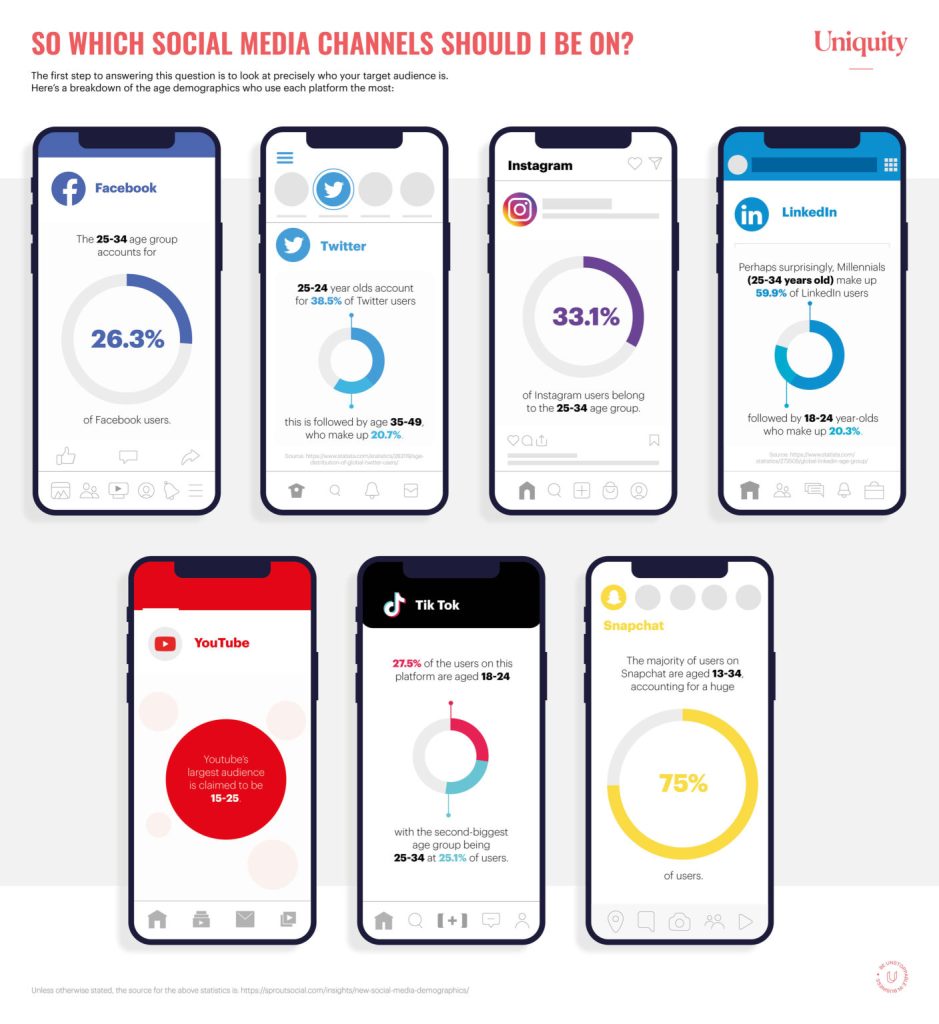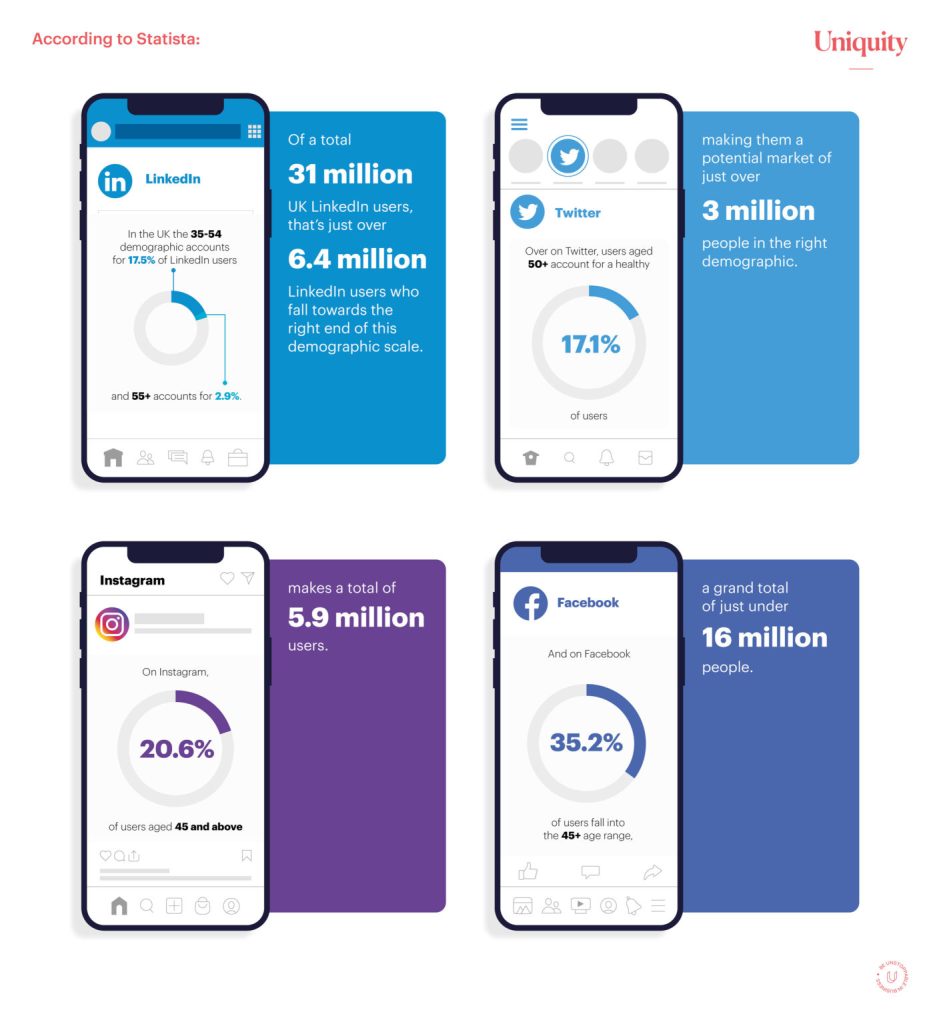To the untrained eye (and the trained, in fact) the sheer volume of social media platforms available right now is pretty overwhelming. Of course, there are the classics – Facebook, Twitter, LinkedIn, Instagram – but in recent years Snapchat and Tik Tok have exploded in popularity. And we haven’t even touched on YouTube, Reddit, Tumblr, WhatsApp, WeChat… the list goes on.
You want to reach as many people as possible, right? So should you be on all the social media channels?
The answer is a resounding ‘no’.
Why? Let’s revise that previous statement: you want to reach as many of the right people as possible.
So which social media channels should I be on?
The first step to answering this question is to look at precisely who your target audience is.
Almost across the board, young Millennials (aged 25-34) make up the majority of social media users. So if this is your target audience, you’ve got the dealer’s choice of where to market age demographic-wise. Coming in a strong second is Gen Z, the 16-24 range, who are pivoting strongly towards newer social media channels and dominating the age demographics on Snapchat and Tik Tok. However, they still have a strong presence on Instagram.

But what about demographics outside of this? What if your ideal client is 55, approaching retirement, working in a decision-making role in a business somewhere in semi-rural England? Where are the pre- and early-retirees hanging out on the internet?
The 50+ Demographic
Percentage-wise, Gen X and Boomer generations seem absent on social media. But anecdotally and statistically, we know that’s simply not the case.
The scale that these platforms are used on is monumental – it’s estimated that 66% of the UK population are active Facebook users. That’s 44.84 million people! So we’re still working with a pretty sizeable market.

While you’re more likely to encounter masses of Millennials on any given social media platform, that doesn’t mean that other age demographics aren’t using it in significant numbers too. And what these figures don’t reflect is how active each age demographic is in comparison to their percentage share of the total user figure. Anecdotally, you’ll see more activity on Facebook from Gen X and Boomer users than you will from Millennials and younger, despite representing a smaller percentage of all Facebook users.
So to answer our previous question – where are the pre- and early-retirees hanging out on the internet? – the answer is ‘everywhere’ (including Tik Tok, where they account for 4.1% of users!).
But you said I shouldn’t be on all the social media platforms!
Correct! You should not. Ultimately, the platforms that are most relevant to you depend on identifying your target market much more specifically. Each platform has its own very specific use, and users will pivot depending on the type of content they’re looking to consume or to post.
If your business targets professionals in decision-making roles, LinkedIn is the place for you. If your ideal client is new grandparents, head on over to Facebook. For on-the-pulse individuals with an interest in current affairs, get on Twitter immediately. And for the creative types, look no further than Instagram.
Which is the best for my financial services brand?
Research from SproutSocial suggests that, surprisingly, Instagram is the best platform for engagement on financial services posts, followed by the tried-and-true Twitter and LinkedIn.
These latter two have been big players in financial services marketing for a while now, and for good reason. They typically have older demographics who are financially minded, and the platforms themselves are well-recognised and well-established homes of professional discourse and networking. They’re like ready-made networking events. Twitter is the more casual and informal of the two, but they hold roughly equal footing.
However, there has been a huge rise in financial services brands on Instagram in recent years, especially those focusing on personal finance, financial education, and fintech brands challenging the industry status quo. With this increased spotlight on financial services, there is certainly space to be made for financial planners and wealth managers, if they’re willing to put a modern twist on how things are done. Instagram has a far more casual, conversational, “behind-the-scenes”-type feel to it. If you arrive on Instagram and behave as though you’re on LinkedIn, you simply won’t get the engagement you’re after.
So, if professionalism, tradition and a polished, corporate feel are important to your brand, then Instagram is probably not for you. However, if it fits your brand to take on a relaxed tone in the appropriate context and you’re unafraid to indulge in a meme every once in a while, it could be a goldmine. You can read more about the importance of brand tone of voice here.
I thought Instagram was just a photography app?
What is this, 2010? Gone are the days when Instagram was the preserve of budding photographers slapping the Valencia filter on moody, grainy photographs of the sea. In 2021, Instagram has made a heavy pivot towards video, presumably to keep up with the popularity of Tik Tok and the rise of video in general.
Marketers often tend to shy away from Instagram since it’s not designed to host clickable links which take your followers to your website to consume content there. Instead, you have to specifically bring your content to Instagram. This takes a slightly bigger investment of time and effort to use and get right. But, done correctly, it can be game-changing.
The possibilities that lie in Instagram’s Live feature are endless and bountiful – Q&A sessions, office tours, a day in the life. Similarly, the app’s algorithm has begun prioritising their Reels videos over static images. These bitesize pieces of content are engaging, highly shareable and, most importantly, require a short attention span to consume. A social media user’s dream.
Instagram Stories are another ideal playground for marketing and engagement. Question stickers, polls, sneak peeks into company life – once more, the possibilities are limitless. This article from Influencer Marketing Hub takes a really comprehensive dive into the current best features to use on Instagram, and how to make the most of them.
The golden rules of social media
There are a few golden rules when it comes to social media for business. The first is to pick one to three platforms (maximum four!) to do really well, and commit to them. The ‘big four’ for financial services are undoubtedly LinkedIn, Twitter, Facebook, and Instagram. There are pros and cons to each, but by and large, these are the big hitters for financial services.
The second is to understand right from the get-go that social media is not a silver bullet that will bring leads through the door in droves. In a service-based industry, that’s just not realistic or feasible.
What it does do is act as a touchpoint. The specific figure is highly debated, but the general consensus among marketers is that it takes at least seven touchpoints before a potential client will engage with you. Social media gives value to potential clients. When you appear in their feed every so often, it reminds them that you exist and lets them observe from afar what you’re like to work with. Then, when the time comes that they’re ready to take action, you’ll be front of mind. Social media functions as one cog in the marketing wheel that will eventually bring a potential client round into being a viable prospect making an enquiry with you.
Thirdly and finally, do not forget the “social” part of “social media”. These platforms are designed to be a conversation. If all you do is post content and leave, that’s the real-life equivalent of opening the door to a room where a conversation is going on, shouting your opinion on something unrelated, and leaving immediately without hearing anybody’s response. Nobody’s going to come after you to continue the conversation after that. If you do it enough times, eventually they won’t even acknowledge you opening the door. Equally as important as posting on social media is interacting with other users – liking, commenting, sharing. It all counts.
What next?
Let’s be honest, it’s complicated. But one thing we know how to do well is to help you work out the best channels for you.
Do you want to know more about making the most of social media for your financial services brand? Or perhaps you would like help revisiting your social media strategy? Then get in touch with us!
We’ll be happy to talk through your needs and figure out how we can help. You can book an initial call here.
This article was written by Sarah Lawrence, our Account Manager.
SOURCES
https://www.statista.com/statistics/283119/age-distribution-of-global-twitter-users/
https://www.statista.com/statistics/273505/global-linkedin-age-group/
https://sproutsocial.com/insights/new-social-media-demographics/
LinkedIn Users By Country and Statistics
Mind-Blowing LinkedIn Statistics and Facts
LinkedIn Usage and Revenue Statistics (2024)
https://www.statista.com/statistics/283119/age-distribution-of-global-twitter-users/
https://www.statista.com/statistics/264810/number-of-monthly-active-facebook-users-worldwide/
https://sproutsocial.com/insights/social-media-statistics/
Sizing Up Twitter Users
https://sproutsocial.com/insights/new-social-media-demographics/
HOW MANY TOUCH POINTS DO YOU NEED TO SELL OUT YOUR SERVICE?
https://sproutsocial.com/insights/new-social-media-demographics/
HOW MANY TOUCH POINTS DO YOU NEED TO SELL OUT YOUR SERVICE?
